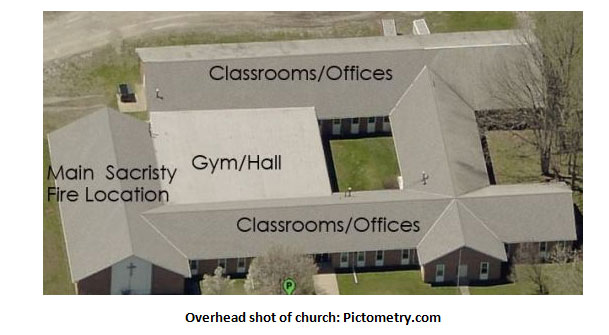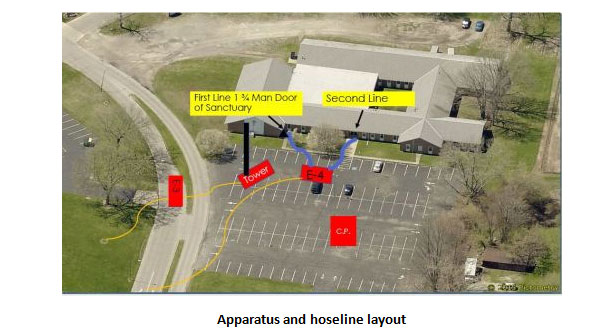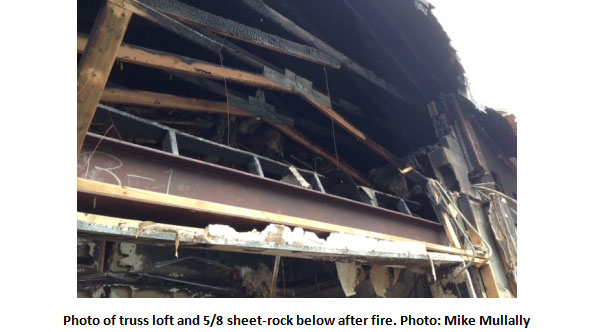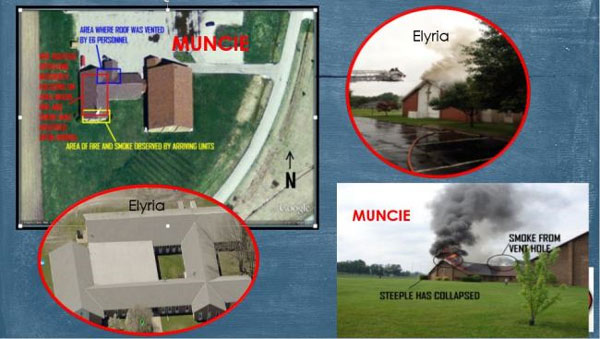
VIEW PRESENTATION >>
By Joe Pronesti
In a recent replay of an FDIC Webcast, FDNY Lt. Ray McCormack emphasized the need to “dig deep” into National Institute for Occupational Safety and Health (NIOSH) firefighter line-of-duty death (LODD) reports and (I paraphrase here) use them in your department’s structure and response. I immediately recalled a fire my department experienced recently that should be considered as a close call and, if my department as a whole would have heeded McCormack’s advice, we may have avoided getting close to such a perilous situation. It is also one of the many reasons behind my passion of developing quick educational references that training officers or whoever can take and immediately give to their members.
My Department
My department is a career department located in Northern Ohio. We cover 21 square miles and 56,000 citizens out of three firehouses. We staff three engines, a truck, and a shift commander in an SUV. Below is a brief synopsis of our event.
June 27 0715 Hours
On June 27th 2015 at 0715 hours, 45 minutes prior to shift change, the Elyria (OH) Fire Department was alerted to a reported fire at 980 Abbe Road North. The occupancy is the College Heights Baptist Church. Heavy rain was falling and a storm had gone through the area during the early morning hours. See diagram and overhead of building below. Hear Dispatch Audio (MP3)

Arrival
Engine 4, staffed by a crew of three members, arrived on the scene at 0718 hours. Acting Lt. Charles Smalley radioed he had “smoke and fire” showing and was going to conduct a 360. MP3: Engine 4 on Scene
Initial Action
After performing the 360 size-up, Engine 4 laid 200 feet of 1 ¾-inch line and went into an entrance door. This led right into the sacristy. The area was clear with good visibility and no heat. The assistant chief (shift commander) arrived and assumed command. He had a second engine arriving to lay a supply to Engine 4 and then ordered an additional attack line laid to prevent any extension from the sacristy area. This line was brought in to the A side front door in the center (see overhead below).

Command also had the truck company set up on the A-B corner. During this time, Engine 4 was still trying to find the seat of the fire. Our communications center give command a “time update” every 20 minutes from the time of the alarm. This check was established with the sole intent of command to re-evaluate conditions and provide a progress report to dispatch that is time stamped. It was during this time that Engine 4 radioed that the ceiling was “coming down” on them and they were retreating to the foyer area. The crew was very fortunate they were able to make it back there the nozzle; 50 feet of line was damaged and buried in the ensuing collapse. Command advised all companies operating to retreat to a safer area, the fire was eventually knocked down with master streams from the tower company and fire was prevented from penetrating into any other areas. MP3: 20-minute update/collapse
Lessons Learned
In speaking with the first-in acting officer–who, by the way, is an excellent firefighter, well-respected and knowledgeable–several thoughts came to light that I would like to share here. First and foremost, the use of the thermal imaging camera (TIC) is not a “tell-all” with regard to conditions above. It was evident from the exterior that fire was involving the attic space of the church, and that the smoke was moving fast or was of any noticeable color to indicate a large amount of fire. The acting officer immediately used his TIC on the interior to scan the ceiling Recall how an imager works–most TICs operate using relative temperature difference, that is the comparison of the things around the TIC. The area under the blazing truss loft never raised above 122 degrees, the 5/8” drywall kept everything insulated. The TIC was giving a false sense of the true environment. The way my department operates, the engine crews very rarely bring in any kind of hooks or pike poles. The two members of the three member company (officer and firefighter) brought in a hand tool and hoseline.
The ability to make an inspection hole is critical when operating in a Type II or V building using modern construction methods (trusses). Making an inspection hole near an exit (front door) or as high as you can where the ceiling meets the wall as in the case of a newer church or large area can be a wise choice and allow quick reconnaissance of the truss loft. Make sure you have the ability to attack fire once holes are made and remember do not let ventilation get ahead of suppression.

Commercial vs Residential
I am proud to be a member of the department I am on. We serve a very diverse community and protect mostly a legacy-constructed residential and commercial structures. I wouldn’t consider us a suburban department. We are best described as a typical “rust belt” Midwest department, and like others we face mostly residential structure fires. Some of the best firefighters in Northern Ohio in my opinion serve arm and arm with me! We must remember however that we cannot take a cookie-cutter approach to all fires. Commercial fires such as this one was a rarer event in the months leading up to this event. Although not an excuse, I wanted to make my point to anyone reading this that the time to prepare is prior to the event and create the environment with correct tactics, training, and procedures that separate the residential from commercial.
RELATED
Fires in Gothic-Style Churches
CHURCH FIRES
CHURCH FIRE: WHEN LIGHTNING STRIKES TWICE
PRECIOUS FAITH TEMPLE CHURCH FIRE , LAKE WORTH, TEXAS
PROTECTING HOUSES OF WORSHIP
Staffing
Like most others, my department has been decimated by cuts. We have gone from four stations to three and five engine companies to three. Our minimal daily strength, while not in writing, is 13 firefighters. A fire with the potential like this one had needed much more than 13 personnel on duty. Mutual aid was not called by the incident commander. Had the collapse trapped our members, we would’ve been in deep trouble. You need more people for a commercial structure fire, period! Review your staffing and auto-aid, mutual aid agreements, etc. Are they set up for a “one-size-fits-all” fire or do they respect the hazard and size, residential vs. commercial?

The Use of NIOSH Reports in EVERYDAY Training
After this fire, I printed out a NIOSH report I previously studied and also had the fireground audio. It reviewed the LODD of a firefighter in Muncie, Indiana. Firefighter Scott Davis, 40, was killed in a structural collapse of the main sacristy area.
The USFA report: Firefighter Davis and the members of his fire department were dispatched to a report of a fire in a large church. First arriving firefighters reported visible flames and heavy smoke coming from the roof. The first arriving company officer called for a second alarm and shortly thereafter special called additional tankers (tenders). Firefighters entered the structure and found mostly clear conditions in the interior of the church. As firefighters began to open up the ceilings to access the attic space, they discovered a considerable amount of fire. Interior crews were having difficulty controlling the fire with a handline. Water supply was an issue; the area of the church did not have fire hydrants. Interior firefighters notified the incident commander that they were withdrawing from the structure. As firefighters were preparing to leave, a structural collapse occurred. An accountability check was conducted and it was realized that Firefighter Davis was missing. Due to the volume of fire, firefighters were unable to access the collapsed area. Firefighter Davis was located when a news helicopter flying over the scene spotted his remains in the debris. The cause of death was listed as smoke inhalation.
After disseminating the report, I was amazed by how many members noted the similarities between our church fire and the one in Muncie. While obviously relieved that we did not have any injuries at our event, I was thoroughly disgusted with myself for not doing a better job as a leader and command officer in not getting these NIOSH reports out and conducting training on them prior to the event.
We need to do a better job incorporating NIOSH and department generated LODD reports into our training. Instead of focusing on the building directly involved in the LODD take a look at buildings in YOUR response area that are of the same generation or “era” as the one involved. This gets your members thinking locally and can really provide a spark in your training and sharing of critical building information.
This type of training is cheap and best served on those days you can’t get out into the district. I had an officer tell me he just doesn’t have the time for such training. Well if you have time to read the paper and have a cup of coffee and shoot the breeze in the morning with your crew, you have an hour that you can review and discuss a LODD. Make a quick power point on the event and then use pics of your buildings either from your files or from a GIS site. “What if” the call of fire in your building rather than attack the actual members and their actions involved in the report.
We were lucky on June 27th, 2015. The use of NIOSH and LODD reports in our training prior to the event can help us all much more than carrying a horseshoe when the bell rings. Look into and add NIOSH reports to your training program. The circumstances reported by NIOSH that contributed to the LODD may not be dead on to the same issues found in Elyria, but every NIOSH report tells a story and opens up a huge training portal for departments.
Review the full incident that claimed the life of Firefighter Scott Davis via PowerPoint HERE.
May Their Sacrifices Not Be in Vain: Lancaster (PA) Firefighter Near Miss Review
May Their Sacrifices Not Be in Vain: Buffalo (NY) LODDs Case Study
May Their Sacrifices Not Be in Vain: Homewood (IL) LODD Case Study
May Their Sacrifices Not Be in Vain: Boston (MA) LODDs Case Study
May Their Sacrifices Not Be in Vain: Bryan (TX) LODD Case Study
 JOSEPH PRONESTI is a 26-year veteran of the Elyria (OH) Fire Department, where he is an assistant chief and shift commander. He is a graduate of the Ohio Fire Chiefs’ Executive Officer program and a lead instructor at the Cuyahoga (OH) County Community College Fire Academy. He is a contributor to fire service publications and sites, including Fire Engineering. He will be presenting a four-hour preconference classroom at FDIC International 2016 titled “Main Street Tactics and Strategies: Are You Ready?” He can be reached at efdcaptain33@gmail.com
JOSEPH PRONESTI is a 26-year veteran of the Elyria (OH) Fire Department, where he is an assistant chief and shift commander. He is a graduate of the Ohio Fire Chiefs’ Executive Officer program and a lead instructor at the Cuyahoga (OH) County Community College Fire Academy. He is a contributor to fire service publications and sites, including Fire Engineering. He will be presenting a four-hour preconference classroom at FDIC International 2016 titled “Main Street Tactics and Strategies: Are You Ready?” He can be reached at efdcaptain33@gmail.com


